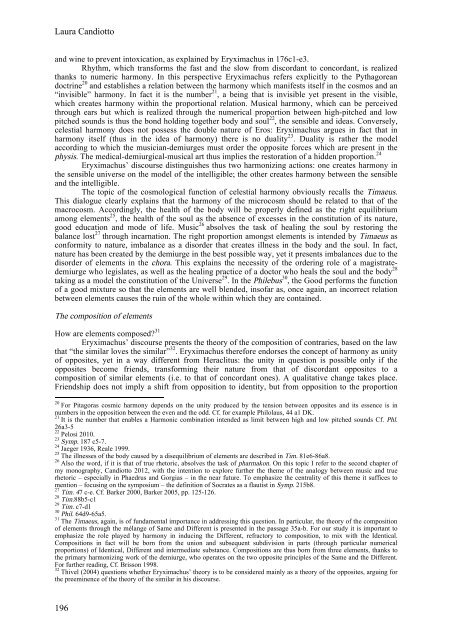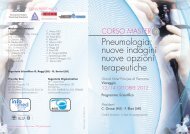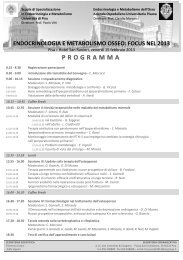You also want an ePaper? Increase the reach of your titles
YUMPU automatically turns print PDFs into web optimized ePapers that Google loves.
Laura Candiotto<br />
and wine to prevent intoxication, as explained by Eryximachus in 176c1-e3.<br />
Rhythm, which transforms the fast and the slow from discordant to concordant, is realized<br />
thanks to numeric harmony. In this perspective Eryximachus refers explicitly to the Pythagorean<br />
doctrine 20 and establishes a relation between the harmony which manifests itself in the cosmos and an<br />
“invisible” harmony. In fact it is the number 21 , a being that is invisible yet present in the visible,<br />
which creates harmony within the proportional relation. Musical harmony, which can be perceived<br />
through ears but which is realized through the numerical proportion between high-pitched and low<br />
pitched sounds is thus the bond holding together body and soul 22 , the sensible and ideas. Conversely,<br />
celestial harmony does not possess the double nature of Eros: Eryximachus argues in fact that in<br />
harmony itself (thus in the idea of harmony) there is no duality 23 . Duality is rather the model<br />
according to which the musician-demiurges must order the opposite forces which are present in the<br />
physis. The medical-demiurgical-musical art thus implies the restoration of a hidden proportion. 24<br />
Eryximachus’ discourse distinguishes thus two harmonizing actions: one creates harmony in<br />
the sensible universe on the model of the intelligible; the other creates harmony between the sensible<br />
and the intelligible.<br />
The topic of the cosmological function of celestial harmony obviously recalls the Timaeus.<br />
This dialogue clearly explains that the harmony of the microcosm should be related to that of the<br />
macrocosm. Accordingly, the health of the body will be properly defined as the right equilibrium<br />
among elements 25 , the health of the soul as the absence of excesses in the constitution of its nature,<br />
good education and mode of life. Music 26 absolves the task of healing the soul by restoring the<br />
balance lost 27 through incarnation. The right proportion amongst elements is intended by Timaeus as<br />
conformity to nature, imbalance as a disorder that creates illness in the body and the soul. In fact,<br />
nature has been created by the demiurge in the best possible way, yet it presents imbalances due to the<br />
disorder of elements in the chora. This explains the necessity of the ordering role of a magistratedemiurge<br />
who legislates, as well as the healing practice of a doctor who heals the soul and the body 28<br />
taking as a model the constitution of the Universe 29 . In the Philebus 30 , the Good performs the function<br />
of a good mixture so that the elements are well blended, insofar as, once again, an incorrect relation<br />
between elements causes the ruin of the whole within which they are contained.<br />
The composition of elements<br />
How are elements composed? 31<br />
Eryximachus’ discourse presents the theory of the composition of contraries, based on the law<br />
that “the similar loves the similar” 32 . Eryximachus therefore endorses the concept of harmony as unity<br />
of opposites, yet in a way different from Heraclitus: the unity in question is possible only if the<br />
opposites become friends, transforming their nature from that of discordant opposites to a<br />
composition of similar elements (i.e. to that of concordant ones). A qualitative change takes place.<br />
Friendship does not imply a shift from opposition to identity, but from opposition to the proportion<br />
20 For Pitagoras cosmic harmony depends on the unity produced by the tension between opposites and its essence is in<br />
numbers in the opposition between the even and the odd. Cf. for example Philolaus, 44 a1 DK.<br />
21 It is the number that enables a Harmonic combination intended as limit between high and low pitched sounds Cf. Phl.<br />
26a3-5<br />
22 Pelosi 2010.<br />
23 Symp. 187 c5-7.<br />
24 Jaeger 1936, Reale 1999.<br />
25 The illnesses of the body caused by a disequilibrium of elements are described in Tim. 81e6-86a8.<br />
26 Also the word, if it is that of true rhetoric, absolves the task of pharmakon. On this topic I refer to the second chapter of<br />
my monography, Candiotto 2012, with the intention to explore further the theme of the analogy between music and true<br />
rhetoric – especially in Phaedrus and Gorgias – in the near future. To emphasize the centrality of this theme it suffices to<br />
mention – focusing on the symposium – the definition of Socrates as a flautist in Symp. 215b8.<br />
27 Tim. 47 c-e. Cf. Barker 2000, Barker 2005, pp. 125-126.<br />
28 Tim.88b5-c1<br />
29 Tim. c7-d1<br />
30 Phil. 64d9-65a5.<br />
31 The Timaeus, again, is of fundamental importance in addressing this question. In particular, the theory of the composition<br />
of elements through the mélange of Same and Different is presented in the passage 35a-b. For our study it is important to<br />
emphasize the role played by harmony in inducing the Different, refractory to composition, to mix with the Identical.<br />
Compositions in fact will be born from the union and subsequent subdivision in parts (through particular numerical<br />
proportions) of Identical, Different and intermediate substance. Compositions are thus born from three elements, thanks to<br />
the primary harmonizing work of the demiurge, who operates on the two opposite principles of the Same and the Different.<br />
For further reading, Cf. Brisson 1998.<br />
32 Thivel (2004) questions whether Eryximachus’ theory is to be considered mainly as a theory of the opposites, arguing for<br />
the preeminence of the theory of the similar in his discourse.<br />
196




